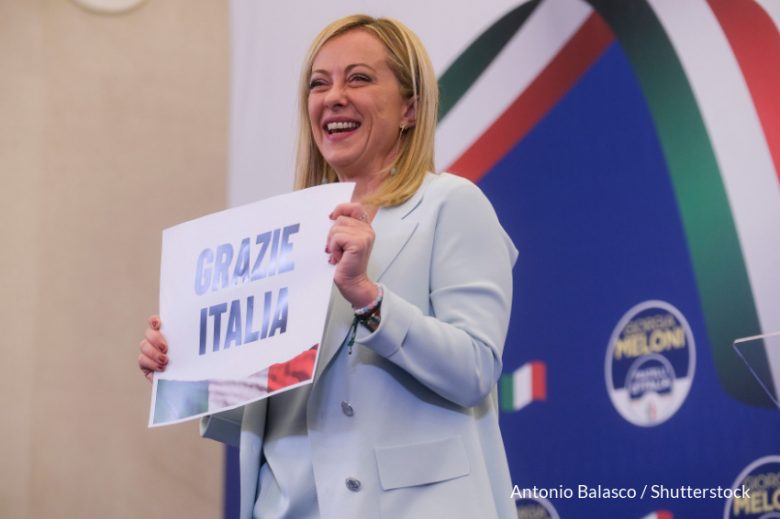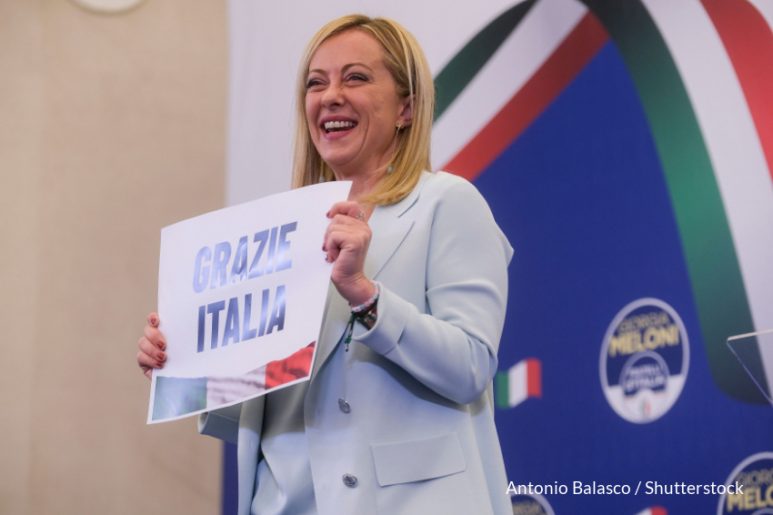By Angelo Boccato
Giorgia Meloni’s success in the Italian elections on September 25 was not surprising, as the far-right leader has been building up support for her party, Brothers of Italy, by absorbing largely the votes of Matteo Salvini’s League, who fell from grace following a long series of debacles and mistakes.
Meloni’s rhetoric was normalised ahead of the most recent elections despite her party’s post-fascist history. But in order to both understand how this normalisation happened and how the Italian media have been affected it is crucial to look at two recent events: the brutal murder of Nigerian street vendor Alika Ogorchukwu in Civitanova Marche, and the rape of a Ukrainian woman in Piacenza, in Emilia-Romagna.

‘The debate on whether Giorgia Meloni’s victory in this year’s elections should be considered a victory for all women was particularly present in Italian media this August. This debate was carried on by female writers, and now that Meloni has won, many men also joined in. Is it really good news, though? If we look at this from a statistical, and a historical perspective, the very fact that a woman will become PM could be seen as good news – if we consider the so-called glass ceiling perspective. This perspective is, however, very limited, and if we look at the politics, vision, and use of power and everything that Giorgia Meloni represents, the answer to this question is surely no,’ Claudia Torrisi, Italian freelance journalist and regular contributor to Open Democracy tells MDI.
Torrisi continues by explaining the gender dynamics of Italian politics and the way they impact Meloni’s agenda.
‘Meloni is a woman in a man’s world, not only because Italian politics is masculine, but also because the structure of the coalition and the party where she finds herself is masculine. She is the only leading woman, something that brings us further away from a chance of an agenda that may push women’s political participation and a closeness to their topics. Meloni is conscious of her gender’s role in carrying a far-right agenda. Meloni uses her gender to sweeten very extremist agendas in terms of migration, LGBTQI subjectivities and also in terms of women’s rights and self-determination,’ she says.
When it comes to the political use of the rape which took place in Piacenza, Torrisi points out how the nationality and skin colour of the perpetrator was central in that narrative
‘The element that Meloni was interested in was whiteness, as the victim was not Italian, just like the perpetrator, but there is a colour line which establishes a sort of hierarchy when gender violence is more or less relevant for right-wing political parties. The rape in Piacenza is quite exemplifying according to various points of view, and, probably, also, from a media perspective is one of the lowest points ever reached. I believe that this was the first time in which a newspaper published a video of sexual violence [the Rome daily newspaper Il Messaggero and others]. This speaks volumes on the level of literacy when it comes to the violence on women in our media environment, as well as on the respect and consideration towards a woman who is a victim of violence,’ Torrisi says.
Meloni, as Torrisi further explains, shared that video through her social media channels, with a caption that pointed out that it is not possible to be silent in front of similar cases of violence, and promised more security in town and cities in case of her electoral success. Right-wing parties, as Torrisi adds, discuss violence against women in specific moments:
‘We are a country where a woman is killed every three days, sexual violence has very high percentages and you would hear very rarely Brothers of Italy, but also right-wing parties abroad, discussing these topics, except when the perpetrator is an asylum seeker, a foreign citizen, someone who belongs to a marginalised category or could prove useful for propaganda purposes.’
Propaganda plays a role but it is not only that. There is a mainstream media environment that does not need encouragement to further propagate these hateful narratives. The colour line, mentioned by Torrisi, is crucial and so central in the narratives of the far-right, in Italy and abroad, in both political propaganda and mainstream media. The brutal murder of Alika Ogorchukwu is a dramatic example of this.
‘At the beginning of this short electoral campaign, we imagined that the right-wing parties would have used their pieces de resistance, like the fight against irregular migration and in general the politics around rights. One of the main recent battles led by right-wing parties has been the one against the Ius Scholae [Italy’s draft citizenship law]. That battle has laid the foundations for an electoral campaign which stressed, once again, this nonexistent, but still strong correlation between citizenship reforms and the presence of foreign citizens in our country and the management of migration flows,’ Adil Mauro, freelance journalist and host of the podcast La Stanza di Adil tells MDI.
As Mauro underlines, when it comes to citizenship reforms this was a testing ground for spreading fear in the population.
‘The murder of Alika Ogorchukwu has not caused so much shock, as we have seen the speed of local figures of the Italian right-wing parties in suffocating the theme of the racial murder. This narrative has been sterilised, and, from my point of view, this has a lot to do with the discrimination of marginalised people in our society. In this case, we had a poor, black and disabled person. There were three levels of analysis that have been ignored one after the other. Other people have seen a racial matrix in this context, a context which has been present for years, in our towns and cities, against marginalised people, like in the case of the murder of Idy Diene,’ Mauro explains.
As Mauro highlights, this can be seen in the categorisation between two types of victims; the good ones and the forgotten ones. ‘Good victims’ such as Willy Monteiro Duarte who was murdered in 2020 could find sympathy within far-right circles, including Meloni, whereas the memory of ‘forgotten victims’ like Abdul William Guibre who was beaten to death and insulted with racist slurs in Milan in 2008 is only kept alive by anti-racist activists.
The discussion of topics such as racism within the context of a political or a media debate is impossible in Italy and this is aided by the country’s mainstream media. But this seems to be changing.
‘I spent the election day with several young Black people at the Blacknèss Fest in Milan, focused on topics like mental health and racial profiling and I have seen that there are already many voices – conscious voices – and this is the great change over the last few years. I believe that is the time to incentivize, support and promote experiences where racialised people and people with a migrant background can meet and exchange views,’ concludes Mauro.
Italy’s new far right government as well as its rhetoric are not reflective of the Italian society. The growth of new voices and the emergence of new media projects have created a collective movement which is building space in the Italian media context.
Photo Credits: Antonio Balasco / Shutterstock

